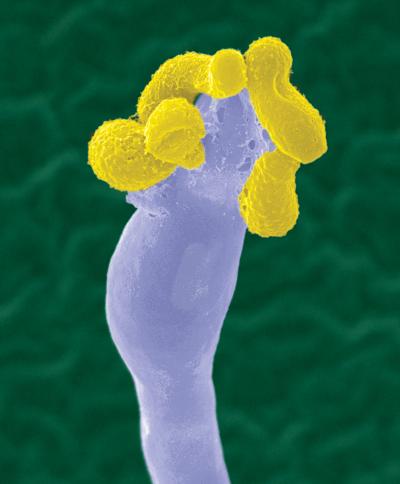Fungus deadly to AIDS patients found to grow on trees

This false-color electron microscope image catches the fungus Cryptococcus gattii in the act of producing its infectious spores. The club-shaped blue structure is a reproductive organ called the basidium, which projects off the fungus body like an apple off a tree. The spores are colored yellow, and are like seeds that can give rise to a new organism. Credit: Center for Microbial Pathogenesis, Duke University
Researchers have pinpointed the environmental source of fungal infections that have been sickening HIV/AIDS patients in Southern California for decades. It literally grows on trees.
The discovery is based on the science project of a 13-year-old girl, who spent the summer gathering soil and tree samples from areas around Los Angeles hardest hit by infections of the fungus named Cryptococcus gattii (CRIP-to-cock-us GAT-ee-eye).
Cryptococcus, which encompasses a number of species including C. gattii, causes life-threatening infections of the lungs and brain and is responsible for one third of all AIDS-related deaths.
The study, which appears Aug. 21 in PLOS Pathogens, found strong genetic evidence that three tree species — Canary Island pine, Pohutukawa and American sweetgum — can serve as environmental hosts and sources of these human infections.
“Just as people who travel to South America are told to be careful about drinking the water, people who visit other areas like California, the Pacific Northwest and Oregon need to be aware that they are at risk for developing a fungal infection, especially if their immune system is compromised,” said Deborah J. Springer, Ph.D., lead study author and postdoctoral fellow in the Center for Microbial Pathogenesis at Duke University School of Medicine.
A few years ago, Duke's chairman of Molecular Genetics and Microbiology, Joseph Heitman M.D., was contacted by longtime collaborator and UCLA infectious disease specialist Scott Filler, M.D., whose daughter Elan was looking for a project to work on during her summer break. They decided it would be fun to send her out in search of fungi living in the greater Los Angeles area.
The student sampled 109 swabs of more than 30 tree species and 58 soil samples, grew and isolated the Cryptococcus fungus, and then sent those specimens to Springer at Duke. Springer DNA-sequenced the samples from California and compared the sequences to those obtained from HIV/AIDS patients with C. gattii infections.
She was surprised to find that specimens from three of the tree species were genetically almost indistinguishable from the patient specimens.
The researchers also found that the C. gattii isolated from the environment were fertile, reproducing either by sexual or asexual reproduction.
“That finding is important for long-term prevalence in the environment, because this fungal pathogen will be able to grow, reproduce, disperse spores, and serve as a source of ongoing infections,” Springer said.
Citation
“Cryptococcus gattii VGIII isolates causing infections in HIV/AIDS patients in Southern California: Identification of the local environmental source as arboreal,” Deborah J. Springer, R. Blake Billmyre, Elan E. Filler, Kerstin Voelz, Rhiannon Pursal, Piotr Mieczkowski, Robert A. Larsen, Fred S. Dietrich, Robin C. Mary, Scott G. Filler, and Joseph Heitman. PLOS Pathogens, August. 21, 2014.
Media Contact
More Information:
http://www.duke.eduAll latest news from the category: Life Sciences and Chemistry
Articles and reports from the Life Sciences and chemistry area deal with applied and basic research into modern biology, chemistry and human medicine.
Valuable information can be found on a range of life sciences fields including bacteriology, biochemistry, bionics, bioinformatics, biophysics, biotechnology, genetics, geobotany, human biology, marine biology, microbiology, molecular biology, cellular biology, zoology, bioinorganic chemistry, microchemistry and environmental chemistry.
Newest articles

Properties of new materials for microchips
… can now be measured well. Reseachers of Delft University of Technology demonstrated measuring performance properties of ultrathin silicon membranes. Making ever smaller and more powerful chips requires new ultrathin…

Floating solar’s potential
… to support sustainable development by addressing climate, water, and energy goals holistically. A new study published this week in Nature Energy raises the potential for floating solar photovoltaics (FPV)…

Skyrmions move at record speeds
… a step towards the computing of the future. An international research team led by scientists from the CNRS1 has discovered that the magnetic nanobubbles2 known as skyrmions can be…





















